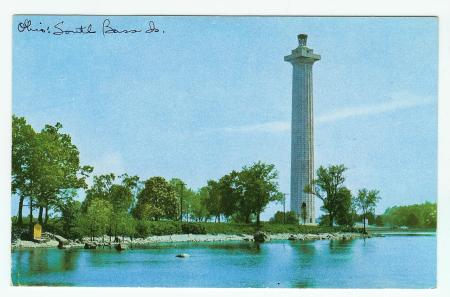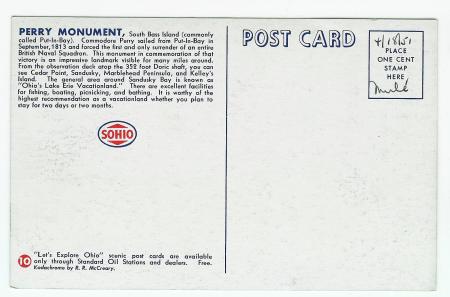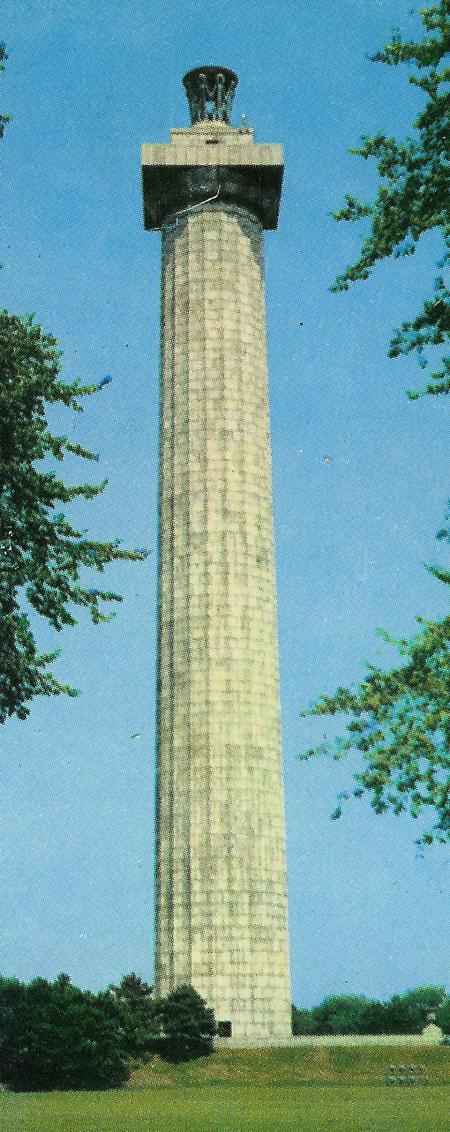There is much activity around South Bass Island and the village of Put-in-Bay over Labor Day weekend, 2013, since celebrations, re-enactments, tall ships, music and more are planned 08/29/2013 through 09/10/2013. The latter date is the bicentennial of the Battle of Lake Erie, in which the American ships under the direction of Commodore Oliver Hazard Perry prevailed over the British fleet. This postcard depicts the monument which was erected in the early 1900s to commemorate the centennial of Perry’s victory:
Sometime after March 3, 1919 and prior to June 13, 1920, the National Board of Memorial Commissioners published a fourteen-page Official Souvenir booklet entitled ‘The Perry’s Victory Memorial — Put-in-Bay — South Bass Island, Ohio’. The booklet is in the public domain, and the copy owned by the Library of Congress is available for viewing as a digital image or as plain text, and for downloading in PDF format. The publication is worth a look for its nine half-tone reproductions of period photographs. The plain text version of the document, however, is rife with typographical and punctuation errors, due to the inability of the optical character reader (OCR) to properly interpret the characters of the text. Example: ‘Amund the walls <if the rotunda are carved stone tablets iji\-ins4- the names of the American shi])s, and the killed on board, engaged in the Battle o{ Lake Erie.’ Here is the brochure text, with typos and punctuation edited to match the PDF version:
*** BEGIN TEXT OF THE PERRY’S VICTORY MEMORIAL ***
The Perry’s Victory Memorial at Put-in-Bay, South Bass Island, Ohio, was erected under the auspices of the United States Government and the States of Ohio, Pennsylvania, Michigan, Illinois, Wisconsin, New York, Rhode Island, Kentucky and Massachusetts (the states being here mentioned in the order in which their Commissioners were appointed, except Massachusetts, which made no provision for Commissioners) in commemoration of the victory of Commodore Oliver Hazard Perry and his men over the British fleet under Commodore Barclay in the Battle of Lake Erie, commonly called Perry’s Victory, fought and won September 10, 1813; and in commemoration of the Northwestern Campaign of General William Henry Harrison in the War of 1812 and of the hundred years of peace ensuing between Great Britain and the United States. In connection with the construction of the Memorial, National and State legislation provided for a Centennial Celebration of the Battle of Lake Erie, which was duly observed under the direction of the Inter-State Board of the Perry’s Victory Centennial Commissioners, September 9-10-11, 1913. These joint enterprises originated in legislation by the State of Ohio, the first Commissioners being appointed by that state in 1909.
The Memorial, plaza and approaches are constructed in their entirety of pink Milford granite from the quarries at Milford, Massachusetts. Its geological composition is particularly adapted to the objects of a monument destined to endure through the ages. The color effect is pure white. The foundations of the column and the plaza rest directly on rock. The Memorial stands on the isthmus of South Bass Island, overlooking the waters of Lake Erie and the scene of Perry’s Victory off West Sister Island. The great Doric column rises 352 feet above the Lake level. It is the highest monument in the world, excepting the Washington Monument; the greatest battle monument in the world and the most massive column ever attempted by ancients or moderns.
The column is forty-five feet in diameter at the base and thirty-five feet and six inches at the neck; thickness of the walls at the base, nine feet and nine inches, and at the neck five feet. The diameter of the clear space in the interior of the column is twenty-six feet, six inches. There are seventy-eight courses of stone in the height of the column. Two flights of granite stairs built in the thickness of the walls afford communication between the four entrance vestibules adjacent to the rotunda and the elevator floor above it. At this level the elevator and staircase start and run to the top of the column. The elevator, protected by all modern safety devices, ascends in one minute. The stairway to the top is composed of 467 steps. From the upper platform a door leads to the outside parapet or spectator’s gallery, capable of accommodating two hundred people in the open air. The entire column is lighted electrically.
From the parapet, 329 feet above Lake Erie, is disclosed a scene of unrivaled beauty. Surmounting the spectator’s gallery is an imposing great bronze tripod, holding the beacon light of the Memorial, which is a glow upward. The tripod is of solid bronze, twenty-three feet in height, its greatest diameter twenty feet; weight, eleven tons; cost, $14,000. It was designed by the architects of the Memorial and cast by the Gorham Company, of New York. It supports a massive bowl for illumination purposes, the top of which is of ground plate glass one half inch thick, having two hundred incandescent lamps beneath it.
The main approach to the Memorial is from Put-in-Bay Harbor. The granite steps ascending to the plaza are sixty-seven feet wide. Entrance to the rotunda of the Memorial is obtained through four bronze doors marking the diameter of the column and facing the cardinal points of the compass. The rotunda is faced with Indiana limestone, and the floor of Tennessee marble, with a centerpiece and border in color. Beneath it, at a spot appropriately marked, repose the remains of the three Americans and three British officers killed in the Battle of Lake Erie, which for a hundred years lay buried on the shores of Put-in-Bay, where they were interred after the battle. They were disinterred by the Commissioners of the Memorial and placed in the Memorial with impressive services September 13, 1913. one hundred years from the date of their original burial on the shore. The seamen killed in the Battle of Lake Erie were buried at sea. The officers killed, whose remains now rest within the Memorial, were (Americans) Lieutenant John Brooks of the brig “Lawrence”: Midshipman Henry Laub, of the “Lawrence.” and Midshipman John Clark, of the schooner “Scorpion”; and (British) Captain Robert Finnis. of the brig “Queen Charlotte”; Lieutenant James Garden, of the Royal New Foundland Regiment, and Lieutenant John Garland. of the ship “Detroit.” Around the walls of the rotunda are carved stone tablets giving the names of the American ships, and the killed on board, engaged in the Battle of Lake Erie.
Around the walls of the elevator floor above, on bronze tablets, are names of all persons engaged in the battle and who received prize money from the government in connection with it—507 names in all. The ceiling of the rotunda takes the form of a dome. At the main entrance are bronze tablets containing the names of the Federal Government, the States and their Commissioners participating in the erection of the Memorial. The Memorial is surrounded by a reservation of fourteen acres, five hundred feet in width between the waters of Put-in-Bay Harbor and those of Lake Erie. Operations to clear the site, originally an unbroken forest, were begun in June, 1912; ground broken for the construction of the Doric column, October 1st, 1912; cornerstone laid, July 4th, 1913; the Memorial opened to the public, June 13, 1915.
Including all items of incidental and necessary expense, the cost of the Memorial was approximately $700,000. For actual construction purposes the Federal Commissioners segregated from the United States funds, $240,000; the Ohio Commissioners, $126,000, and $20,000 additional for the improvement of the grounds; Pennsylvania, $50,000; Michigan, $25,000; Illinois, $30,000; Wisconsin, $25,000; New York, $30,000; Rhode Island, $25,000; Kentucky, $25,000; and Massachusetts, $15,000. Total, $611,000. These figures, however, do not include the necessary cost of the purchase of the Memorial site, of the architectural competition, superintendence of construction, fees for engineers, electrical conduits, retaining walls, and the organization necessary to promote and carry on the work over a period of years.
The architect and designer of the Memorial was Joseph H. Freedlander, of New York, with whom was associated A. Duncan Seymour, of New York. The successful design was determined in the largest architectural competition ever held in this country or Europe. The competitive designs were exhibited in the National Museum, Washington, and the judges of awards were the members of the National Fine Arts Commission, consisting of David H. Burnham, architect, Thomas Hastings, architect, Cass Gilbert, architect, Daniel C. French, sculptor, Frank D. Miller, painter, Frederick Law Olmstead, architect, and Charles Moore, art connoisseur. The Building Committee of the Memorial, authorized by the Inter-State Board of Commissioners, consisted of President-General George H. Worthington, chairman; First Vice-President-General Henry Watterson; United States Commissioner Nelson A. Miles; with Secretary-General Webster P. Huntington as secretary. The Doric column was constructed by J. C. Robinson & Son, of New York and Chicago, and the plaza and approaches by the Stewart Engineering Corporation, of New York, both under the supervision of Superintendent of Construction C. E. Sudler. The Custodian of the Memorial is S. M. Johannsen, of the Ohio Commission, residing at Put-in-Bay.
The Commissioners appointed by the President of the United States and the Governors of the States participating in the erection of the Memorial organized the Inter-State Board of the Perry’s Victory Centennial Commissioners at a meeting held at Put-in-Bay, September 10th, 1910. This organization has since continued and is now known, by act of Congress, as the Perry’s Victory Memorial Commission. At the period of the Centennial Celebration in 1913 it was composed of the following Commissioners:
General Officers: President-General, George H. Worthington, Cleveland, Ohio; First Vice-President-General, Henry Watterson, Louisville, Kentucky; Secretary-General, Webster P. Huntington, Columbus, Ohio; Treasurer-General, A. E. Sisson, Erie, Pennsylvania; Auditor-General, Colonel Harry Cutler, Providence, Rhode Island; Financial Secretary, Mackenzie R. Todd, Frankfort, Kentucky.
Commissioners: For the United States Government, Lieutenant General Nelson A. Miles, U. S. A., Ret., Washington, D. C.; Rear Admiral Charles H. Davis, U. S. N. Ret., Washington, D. C.; Major General J. Warren Keifer, Springfield, Ohio.
Ohio: John H. Clarke, George H. Worthington, Cleveland; Webster P. Huntington, Columbus; S. M. Johannsen, Put-in-Bay; Eli Winkler, Nicholas Longworth, Cincinnati; Horace Holbrook, Warren; William C. Mooney, Woodsfield; Horace L. Chapman, Columbus; George W. Dun, Toledo.
Pennsylvania: A. E. Sisson, Milton W. Shreve, Erie; Edwin H. Vare, Philadelphia; T. C. Jones, McKeesport; George W. Nefi, M. D., Masontown.
Michigan: George W. Parker, John C. Lodge, Detroit; Arthur P. Loomis, Lansing; Roy S. Barnhart, Grand Rapids; E. K. Warren, Three Oaks.
Illinois: William H. Thompson, James Pugh, Richard S. Folsom, Nelson W. Lampert, Adam Weckler, Chesley R. Perry, William Porter Adams, Willis J. Wells, Chicago; General Philip C. Hayes, Joliet; W . H. Mcintosh, Rockford ; H. S. Bekemeyer, Springheld.
Wisconsin: Rear Admiral Frederick M. Symonds, U. S. N. Ret., Galesville; John M. Whitehead, Janesville; A. W. Sanborn, Ashland; Louis Bohmrich, Milwaukee; C. B. Perry, Wauwatosa; S. W. Randolph, Manitowoc; Sol P. Huntington, Green Bay. (Joseph McBell, Secretary, Milwaukee.)
New York: William J. Conners, George D. Emerson, William Simon, John F. Malone, Edward D. Jackson, Buffalo; Simon L. Adler, Rochester; Martin H. Glynn, Albany; Clinton B. Herrick, M. D., Troy; William F. Rafferty, Syracuse; William L. Ormrod, Churchville; Jacob Schifferdecker, Brooklyn.
Rhode Island: John P. Sanborn, Newport; Louis N. Arnold, Westerly; Sumner Mowry, Peace Dale; Henry E. Davis, Woonsocket; Colonel Harry Cutler, Providence.
Kentucky: Henry Watterson, Colonel Andrew Cowan, Louisville; Samuel M. Wilson, Lexington; Colonel R. W. Nelson, Newport; Mackenzie R. Todd, Frankfort.
The General Officers of the Inter-State Board have been annually re-elected since 1910.
The Memorial and Reservation are the property of the United States Government, and the Reservation a national park, both under the direction and control of the Perry’s Victory Memorial Commission, created by Act of Congress approved by President Wilson March 3d, 1919. The property contained in the Reservation was originally purchased from private owners, for the objects to which it has been dedicated, by condemnation proceedings brought in the name of the State of Ohio, and the title vested in that State. By act of the General Assembly of Ohio the property was ceded to the United Slates, and the title was accepted on the part of the United States by the Act of Congress referred to.
The view from the top of the Memorial is never forgotten by those who have had the privilege of ascending. By day the picture grows upon the senses with charming allurement, while night reveals a fairyland of starlit skies, shadowy forms and shimmering reflections.
From an architectural standpoint the Memorial is one of the great works of the ages, happily destined to endure as long as any reared by human hands. Scientifically, it has been the subject of unbounded admiration on the part of experts of both hemispheres. The public has not been slow to realize the educational value of a visit to Put-in-Bay and the Memorial. The Island is readily accessible by daily boats from Sandusky, Toledo, Cleveland and Detroit. The throngs of visitors to the Memorial therefore naturally include many organizations and societies. Special rates for transportation and hotel accommodations may always be obtained.
*** END TEXT OF THE PERRY’S VICTORY MEMORIAL ***
The present-day (2013) name of this National Park is “Perry’s Victory and International Peace Memorial”.
Tags: "International Peace Memorial", "Oliver Hazard Perry", "Perry's Victory Memorial", "September 10 1813", "South Bass Island", "War of 1812", bicentennial, post card, postcard."vintage postcard", Put-in-Bay



Leave a comment